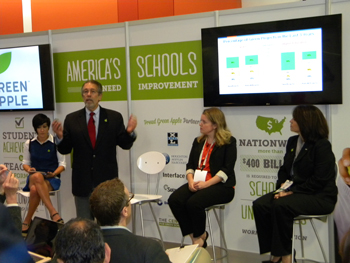Panel Educates Greenbuild Attendees on Benefits of Green Schools
 The U.S. Green Building Council’s (USGBC) Center for Green Schools hosted a press conference titled the State of our Schools at the annual Greenbuild expo, which took place in San Francisco last week. The conference was part of USGBC’s Green Apple initiative, which is a collaboration with the Clinton Global Initiative intended to put all children in sustainable schools with an emphasis on air quality and circulation.
The U.S. Green Building Council’s (USGBC) Center for Green Schools hosted a press conference titled the State of our Schools at the annual Greenbuild expo, which took place in San Francisco last week. The conference was part of USGBC’s Green Apple initiative, which is a collaboration with the Clinton Global Initiative intended to put all children in sustainable schools with an emphasis on air quality and circulation.
The conference consisted of a panel discussion hosted by Rachel Gutter, director of the Center for Green Schools. Harvey Bernstein, vice president, industry insights and alliances, McGraw-Hill Construction presented a preview of a report his firm is in the process of completing, called the New & Retrofit Green School study. The full study will be released in the first quarter of 2013 as part of McGraw-Hill’s Smartmarket Report series.
The panel was rounded out by Jessica Hubbard, director, corporate social responsibility, Houghton Mifflin Harcourt, and Irene Nigaglioni, chair, Council of Educational Facility Planners International and partner at PBK Architects.
The presenters all emphasized that green building had taken a sharp turn recently in the educational market, changing from a luxury that could only be considered by well-off schools, to a standard. Hubbard said many people in the industry viewed green as a niche market until research started to suggest that green building designs had an array of positive impacts on the classroom experience for teachers and students. She explained this was a real eye opener and a watershed moment, when green stopped seeming like a cultural movement and changed into a strategic solution for improving outcomes and health in the classroom.
Bernstein cited several interesting and surprising results that would be included in the upcoming McGraw-Hill report. He explained that schools with green features saw a 32-percent reduction in absenteeism and a 68-percent increase in the quality of test scores. He added that higher educational facilities have seen a 40-percent increase in test performance when adding green designs to their campus. He explained these findings were shocking enough to be taken very seriously, but cautioned that data for these studies only went back to 2007.
Hubbard said one explanation for the results was that air circulation had been linked very directly to classroom outcomes. She said facilities with limited airflow caused students and teachers to feel more lethargic and experience difficulties concentrating.
Nigaglioni explained the next big step for schools would be to find ways to work their green facilities into the curriculum and educate students about the science behind the technology in their classrooms.
Gutter said colleges were beginning to find the recruiting benefits of green building. She explained that a recent survey found 69 percent of high school students considered the green aspects of a campus when deciding where to apply for college.
Bernstein brought the conversation full circle, explaining he had two sons, one an engineer and one an architect, who already saw the world differently than he does. He said the next generation of designers viewed green as the standard, the only way to build and that the world would turn in that direction as well, when parents retire and hand it over to their children.
